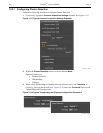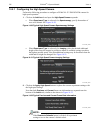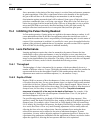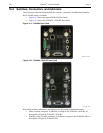
232 PI-MAX
®
4 System Manual Issue 4
15.2.3 Adjusting the Signal Delay
The PI-MAX4 internal timing generator gives the user wide latitude with respect to
adjusting the delay between the time the timing generator is triggered and the time the Gate
On and Off edges are generated. This being the case, as long as the light signal applied to
the camera occurs
after the minimum delay time of the timing generator (~25 ns,) there will
be no problem establishing the necessary coincidence.
On the other hand, if the light signal applied to the camera occurs
before the minimum
delay time of the timing generator, then no amount of adjusting the delay at the timing
generator can rectify the problem. The light signal itself will have to be delayed.
If a common source is triggering both the timing generator and the laser, a very convenient
solution is to insert an electrical delay by placing a long cable between the trigger source
and the laser. This is generally preferable to establishing the necessary delay optically via
mirrors or fiber optic cable.
Alternatively, pass the laser output through a length of optical fiber cable. By using different
lengths of fiber, almost any desired signal delay can be achieved. Yet another solution
would be to set up two separated parallel mirrors with a small angle between them.
Typically, it will be easily possible to bounce the laser beam back and forth between the
mirrors half a dozen times to obtain the necessary delay. In any case, once the light signal is
arriving at the camera
after the minimum gate time, the timing generator delay adjustments
can be used to bring them into coincidence. Keep in mind that using optical cable or mirrors
to delay the signal will carry some intensity penalty, which might have an adverse affect on
measurement results in some experiments.
15.2.4 Optimizing the Gate Width and Delay
When the basic delay questions have been answered, the next consideration is optimization
of the Gate Width and Delay. The goal is to have the gate just bracket the signal event. One
effective approach is to:
1. Begin with minimum delay and a gate width far wider than the optical signal pulse to be
measured.
2. While observing the data signal at the computer monitor, gradually increase the delay
until the event vanishes. This will mark the point at which the gate is opening just after
the signal, causing the signal to be lost.
3. Reduce the delay until the signal reappears.
4. Then begin reducing the gate width (not the delay.) As the gate is narrowed, the amount
of Equivalent Background Illumination (EBI) generated will decrease so the
signal-to-noise ratio should improve. When the point is reached where the gate becomes
narrower than the signal being measured, the observed signal data will degrade. You
may have to adjust the delay to keep the signal in view.
5. From there increase the width slightly for maximum signal and optimum
signal-to-noise.


















